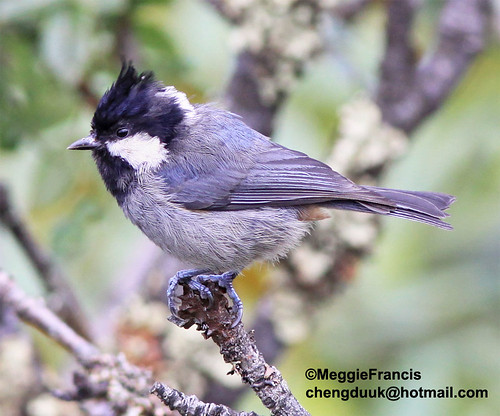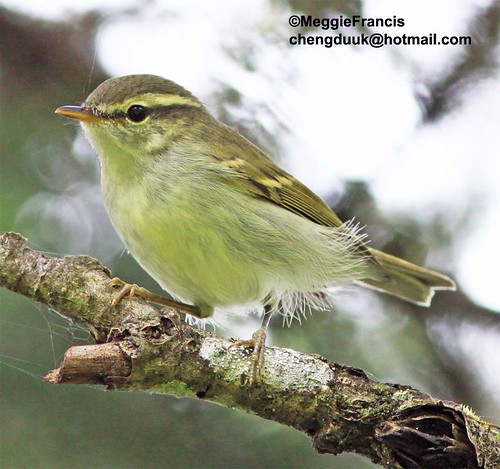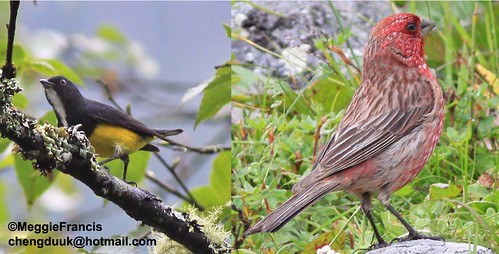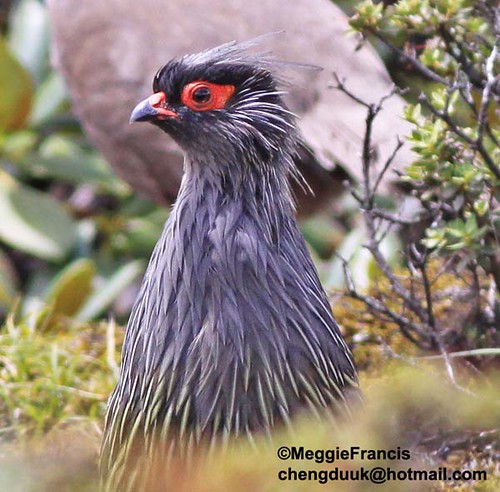Chengdu Bird guiding – [email protected] - Chengdu, Sichuan, the gateway to Tibet - to see more travel pics of Sichuan go to my travel blog at - http://chengdutravel.blogspot.com/
To see more of our birding pics go to - http://sichuanbirds.blogspot.com/
For More Sichuan bird info go to our Sichaun Birding thread - http://www.birdforum.net/showthread.php?t=149725

Rufous-vented Tit - this is a nice little bird – it’s a common Tit at higher elevations. These birds were seen at around the 4000m mark - noisily flying around in scrub that forms around the tree-line. Nosy and inquisitive the pictured bird is showing a hint of rufous around the vent area and the slightest of touches under the wing covert. However those dabs of color, which give this bird its name can be difficult to see in the field - but with that crown, black bib that stops at the throat area and the smart blue-gray breast/belly - this bird is pretty easy to recognise.
Well, we tried, again, to stay at home - this time succeeding for 4 days, before the strain got too much and off we set for one of our favourite spots - Moxi. This is a town that's about 5/6 hours drive from Chengdu – most of the drive going along the G318 highway that eventually ends up in Lhassa.
We were pleased road workings - just past Ya'an - that have been causing hold-ups, are now near complete. However, further on, the state of the road seems to promise more repair delays in the near future.
Moxi town provides a whole load of hotels that service the Hailuogou Glacier park - a tourist site that gives views over the magnificent 7000m Gongga Mountain. But these intrepid blogsters always stay in a Lorry driver hotel - just on the edge of town. It’s a bit grotty - but under 3 quid/night its very cheap ($5) - and we've been staying at this place for years. For those who need more luxury there's ample choice - please don't follow our lead on the accommodation front!!!!!!!!!!!!
As for food, we just go the local farmers market and buy salad veggies, one of the many varieties of freshly cooked meat (you can get Yak up here), a bottle of Sesame oil, salt/dried red-peppers to make a salad sauce and some local flat-bread - and we can dish-up an extremely good-tasting, but cheap meal in our hotel room.
By the way we've been eating salad here for years - never any stomach problems - if we ever do get a gripe it’s invariably from a restaurant cooked meal!!!! But saying that - one of the great pleasures of exploring China is to sample the local cuisine - and Moxi has all sorts of restaurants - but the longer you've been here..... well we like making our own food!

Greenish Warbler - the lighting in this pic has given this bird a strong yellowish tinge to the breast (other pics have a plainer breast) - that solid cap (no hint of median crown stripe) - the orange under mandible - sparrow like cheep (you have to take my word on that one) - and a double wing-bar meet the identification points for ssp. plumbeitarsus - or Two-barred Greenish Warbler. This bird is supposed to be common in NE China - and migrant through the rest of China - but we have been picking up very similar birds all Summer.
Leaf Warblers can be a bit of a nightmare in Sichuan - so many species - often hard to identify - no wonder many of our guests get Leaf Warbler fatigue after 3 or 4 days hectic neck stretching.
This trip brought many Large-billed on the lower areas and a mass of Buff-barred and Tickell's from around 3500m.
To bird around Moxi - you don't need to the Hailuogou Glacier Park, since much of the time you're not allowed to walk and are bussed in a party, often have to share your birding with a noisy tourist crowd and the whole experience will cost an entrance ticket. We bird the areas that are found outside town in the direction of the small road that leads over a 4000m mountain pass that winds its way to Kangding. This route will take you to various elevation Zones - in the spring and summer 3000 - 4000m generally gives the most interesting watching - but in the winter great birding is found in the lower scrub/marginal farmland around the 2000m when many of the high altitude species come down - and form big mixed flocks.
For those who aren't with guide or driver, its not so difficult to find transport with which explore this areas - at the main-cross in Moxi there are plenty of motorbike taxis or minivans that can be cheaply hired. On the way home it’s a matter of flagging down passing transport. I think the best tactic is to get your driver to take you about 20km out of town - from here you can walk the road and the explore paths that take you into other interesting areas.
On this last trip we had Yellow-bellied Flowerpecker, both Great and Brown Parrotbill and Darjeeling woodpecker as roadside birds - during past trips the road has given us goodies like Pere David's Tit, Green-backed Shrike-babbler and Crimson-browed Finch. Searching – with bins - those meadows that make up the lower parts of the valleys can give a chance for Lady A Pheasant.
At the very top - which is just on 4000m - you've got the chance to walk into an area of high grassland - which has an interesting flora that includes a lot of Rhododendron scrub.
This is a good site to tick off some of the high altitude species like - Tickell's Leaf Warbler, Rufous-breasted Accentor, Blue-fronted Redstart and White-browed Rosefinch - Blood Pheasant and Monal Pheasant are also around but it's best to go a tad lower for these species.. During this last trip we were able to pick up Streaked Rosefich and a juv. Himalayan Rubythroat at this top area - and Chinese Fulvetta and White-browed Tit Warbler were briefly seen through the tangle of Rhody stems.

From left to right - Yellow-bellied Flowerpecker and Streaked Rosefinch - these were two of our latest Moxi photographs that caught birds that have not been pictured on OPUS. Moxi is an area that invariably turns-up rare and unusual species - In previous blogs, other birds we've pictured here from have included Crimson-browed Finch and the Sharpe's ssp. of Spot-winged Rosefinch - high quality birding!!!!!
This is one of the areas that gets very little attention from visiting birders - but makes for a handy birding destination - because of a combination of varied habitat types that can be observed from a single road and its close proximity to Chengdu. It's a location that can easily be fitted into a short Sichuan tour that also takes in sites like Emei and Wawu.
Like many great Chinese birding areas, Moxi is very vulnerable to development and change - at the top pass workers are quarrying sand which has caused a lot of habitat destruction - large numbers of domestic goat and sheep are causing damage to the scrub and forest areas - and there's always the threat of poaching and illegal logging. So more foreign birdwatchers visiting - making important sightings - will hopefully help give this area a higher profile and encourage local authorities to put more effort into conservation and protection measures. We need more foreign birders out this way!!!!!!!!

And of course it isn't just the birding that brings us to Moxi. Here's a pic from several years ago - taken in one of the valleys that lead up to the 7000m Mt. Gongga. It was love at first sight - and me and Meggie - being very greedy - just can't stop coming back for more!!!!!
To see more of our birding pics go to - http://sichuanbirds.blogspot.com/
For More Sichuan bird info go to our Sichaun Birding thread - http://www.birdforum.net/showthread.php?t=149725

Rufous-vented Tit - this is a nice little bird – it’s a common Tit at higher elevations. These birds were seen at around the 4000m mark - noisily flying around in scrub that forms around the tree-line. Nosy and inquisitive the pictured bird is showing a hint of rufous around the vent area and the slightest of touches under the wing covert. However those dabs of color, which give this bird its name can be difficult to see in the field - but with that crown, black bib that stops at the throat area and the smart blue-gray breast/belly - this bird is pretty easy to recognise.
Well, we tried, again, to stay at home - this time succeeding for 4 days, before the strain got too much and off we set for one of our favourite spots - Moxi. This is a town that's about 5/6 hours drive from Chengdu – most of the drive going along the G318 highway that eventually ends up in Lhassa.
We were pleased road workings - just past Ya'an - that have been causing hold-ups, are now near complete. However, further on, the state of the road seems to promise more repair delays in the near future.
Moxi town provides a whole load of hotels that service the Hailuogou Glacier park - a tourist site that gives views over the magnificent 7000m Gongga Mountain. But these intrepid blogsters always stay in a Lorry driver hotel - just on the edge of town. It’s a bit grotty - but under 3 quid/night its very cheap ($5) - and we've been staying at this place for years. For those who need more luxury there's ample choice - please don't follow our lead on the accommodation front!!!!!!!!!!!!
As for food, we just go the local farmers market and buy salad veggies, one of the many varieties of freshly cooked meat (you can get Yak up here), a bottle of Sesame oil, salt/dried red-peppers to make a salad sauce and some local flat-bread - and we can dish-up an extremely good-tasting, but cheap meal in our hotel room.
By the way we've been eating salad here for years - never any stomach problems - if we ever do get a gripe it’s invariably from a restaurant cooked meal!!!! But saying that - one of the great pleasures of exploring China is to sample the local cuisine - and Moxi has all sorts of restaurants - but the longer you've been here..... well we like making our own food!

Greenish Warbler - the lighting in this pic has given this bird a strong yellowish tinge to the breast (other pics have a plainer breast) - that solid cap (no hint of median crown stripe) - the orange under mandible - sparrow like cheep (you have to take my word on that one) - and a double wing-bar meet the identification points for ssp. plumbeitarsus - or Two-barred Greenish Warbler. This bird is supposed to be common in NE China - and migrant through the rest of China - but we have been picking up very similar birds all Summer.
Leaf Warblers can be a bit of a nightmare in Sichuan - so many species - often hard to identify - no wonder many of our guests get Leaf Warbler fatigue after 3 or 4 days hectic neck stretching.
This trip brought many Large-billed on the lower areas and a mass of Buff-barred and Tickell's from around 3500m.
To bird around Moxi - you don't need to the Hailuogou Glacier Park, since much of the time you're not allowed to walk and are bussed in a party, often have to share your birding with a noisy tourist crowd and the whole experience will cost an entrance ticket. We bird the areas that are found outside town in the direction of the small road that leads over a 4000m mountain pass that winds its way to Kangding. This route will take you to various elevation Zones - in the spring and summer 3000 - 4000m generally gives the most interesting watching - but in the winter great birding is found in the lower scrub/marginal farmland around the 2000m when many of the high altitude species come down - and form big mixed flocks.
For those who aren't with guide or driver, its not so difficult to find transport with which explore this areas - at the main-cross in Moxi there are plenty of motorbike taxis or minivans that can be cheaply hired. On the way home it’s a matter of flagging down passing transport. I think the best tactic is to get your driver to take you about 20km out of town - from here you can walk the road and the explore paths that take you into other interesting areas.
On this last trip we had Yellow-bellied Flowerpecker, both Great and Brown Parrotbill and Darjeeling woodpecker as roadside birds - during past trips the road has given us goodies like Pere David's Tit, Green-backed Shrike-babbler and Crimson-browed Finch. Searching – with bins - those meadows that make up the lower parts of the valleys can give a chance for Lady A Pheasant.
At the very top - which is just on 4000m - you've got the chance to walk into an area of high grassland - which has an interesting flora that includes a lot of Rhododendron scrub.
This is a good site to tick off some of the high altitude species like - Tickell's Leaf Warbler, Rufous-breasted Accentor, Blue-fronted Redstart and White-browed Rosefinch - Blood Pheasant and Monal Pheasant are also around but it's best to go a tad lower for these species.. During this last trip we were able to pick up Streaked Rosefich and a juv. Himalayan Rubythroat at this top area - and Chinese Fulvetta and White-browed Tit Warbler were briefly seen through the tangle of Rhody stems.

From left to right - Yellow-bellied Flowerpecker and Streaked Rosefinch - these were two of our latest Moxi photographs that caught birds that have not been pictured on OPUS. Moxi is an area that invariably turns-up rare and unusual species - In previous blogs, other birds we've pictured here from have included Crimson-browed Finch and the Sharpe's ssp. of Spot-winged Rosefinch - high quality birding!!!!!
This is one of the areas that gets very little attention from visiting birders - but makes for a handy birding destination - because of a combination of varied habitat types that can be observed from a single road and its close proximity to Chengdu. It's a location that can easily be fitted into a short Sichuan tour that also takes in sites like Emei and Wawu.
Like many great Chinese birding areas, Moxi is very vulnerable to development and change - at the top pass workers are quarrying sand which has caused a lot of habitat destruction - large numbers of domestic goat and sheep are causing damage to the scrub and forest areas - and there's always the threat of poaching and illegal logging. So more foreign birdwatchers visiting - making important sightings - will hopefully help give this area a higher profile and encourage local authorities to put more effort into conservation and protection measures. We need more foreign birders out this way!!!!!!!!

And of course it isn't just the birding that brings us to Moxi. Here's a pic from several years ago - taken in one of the valleys that lead up to the 7000m Mt. Gongga. It was love at first sight - and me and Meggie - being very greedy - just can't stop coming back for more!!!!!




